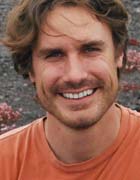Loading
Gábor Szabó
- Name: Gábor Szabó
- Email:[email protected]
- 2011- : Twitter, Inc., San Francisco, CA
Senior data scientist - 2007–2011: Hewlett-Packard Laboratories, Social Computing Laboratory, Palo Alto, CA
Research scientist, working with HP Labs senior fellow Bernardo Huberman - 2005–2006 Harvard Medical School, Boston, MA
Postdoctoral fellow, working with Prof. Albert-László Barabási - 2004–2006 University of Notre Dame, Department of Physics, Notre Dame, IN
Postdoctoral fellow, working with Prof. Albert-László Barabási
- 2001–2004 Budapest University of Technology and Economics, Hungary
Ph.D. in Statistical and Computational Physics (summa cum laude), advisor: János Kertész - 1996–2001 Budapest University of Technology and Economics, Hungary
M.Sc. in Physics, advisor: János Kertész
Online social media
- S. Asur, B.A. Huberman, G. Szabó, and C. Wang, “Trends in Social Media: Persistence and Decay ”, Proceedings of the 5th International AAAI Conference on Weblogs and Social Media, 434 (2011).
- G. Szabó and B.A. Huberman, “Predicting the popularity of online content”, Communications of the ACM 53 (8), 80–88 (August 2010).
- G. Szabó, A. Ankolekar, J. Edlund, and B.A. Huberman, “Friendlee: A mobile application for your social life”, HP TechCon, one of 130 accepted papers out of 1300 submissions (2010).
- A. Ankolekar, G. Szabó, Y. Luon, B.A. Huberman, D. Wilkinson, and F. Wu , “Friendlee: A mobile application for your social life”, Proceedings of the 11th International Conference on Human-Computer Interaction with Mobile Devices and Services (2009).
- T. Hogg and G. Szabó, “Dynamics and diversity of online community activities”, Europhysics Letters 86, 38003 (2009).
- T. Hogg and G. Szabó, “Diversity of user activity and content quality in online communities”, Proceedings of the 3rd International AAAI Conference on Weblogs and Social Media (2009).
- M. Brzozowski, T. Hogg, and G. Szabó, “Friends and foes: Ideological social networking”, Proceedings of the 26th Annual SIGCHI Conference on Human Factors in Computing Systems, 817–820 (2008).
- T. Hogg, D. Wilkinson, G. Szabó, and M. Brzozowski, “Multiple relationship types in online communities and social networks”, Proceedings of the AAAI Symposium on Social Information Processing (2008).
Social and communication networks
- J.-P. Onnela, J. Saramäki, J. Hyvönen, G. Szabó, D. Lazer, K. Kaski, J. Kertész, and A.-L. Barabási, “Structure and tie strengths in mobile communication networks”, Proceedings of the National Academy of Sciences 104, 7332–7336 (2007).
- J.-P. Onnela, J. Saramäki, J. Hyvönen, G. Szabó, M. Argollo de Menezes, Kimmo Kaski, A.-L. Barabási, and J. Kertész, “Analysis of a large-scale weighted network of one-to-one human communication”, New Journal of Physics 9, 179 (2007).
- G. Szabó and A.-L. Barabási, “Network effects in service usage”, preprint arXiv physics/0611177 (2006).
- T. Schoenharl, G. Madey, G. Szabó, and A.-L. Barabási, “WIPER: A multi-agent system for emergency response”, Proceedings of the 3rd International ISCRAM Conference, B. Van de Walle and M. Turoff, eds., Newark, NJ, USA, May 2006.
- G. Madey, G. Szabó, and A.-L. Barabási, “WIPER: The integrated wireless phone-based emergency response system”, Computational Science–ICCS 2006: 6th International Conference, Reading, UK, May 2006, Lecture Notes in Computer Science 3993, 417–424 (2006).
- G. Szabó, “Book Review: Evolution and structure of the Internet: A statistical physics approach, by R. Pastor-Satorras and A. Vespignani”, Journal of Statistical Physics 122, 1297–1298 (2006).
- G. Szabó, “Mapping a communication tree with correlation of packets”, International Journal of Modern Physics C 16, 647–654 (2005).
- G. Szabó, M. Alava, and J. Kertész, “Geometry of minimum spanning trees on scale-free networks”, Physica A 330, 31–36 (2003).
- G. Szabó, M. Alava, and J. Kertész, “Structural transitions in scale-free networks”, Physical Review E 67, 056102 [5 pages] (2003).
- G. Szabó, M. Alava, and J. Kertész, “Shortest paths and load scaling in scale-free trees”, Physical Review E 66, 026101 [8 pages] (2002).
Protein networks
- P. Lamesch, N. Li, S. Milstein, C. Fan, T. Hao, G. Szabó, Z. Hu, K. Venkatesan, G. Bethel, P. Martin, J. Rogers, S. Lawlor, S. McLaren, A. Dricot, H. Borick, M.E. Cusick, J. Vandenhaute, I. Dunham, D.E. Hill, and M. Vidal, “hORFeome v3.1: A resource of human open reading frames representing over 10,000 human genes”, Genomics 89, 307–315 (2007).
- J. Lim, T. Hao, C. Shaw, A.J. Patel, G. Szabó, J.-F. Rual, C.J. Fisk, N. Li, A. Smolyar, D.E. Hill, A.-L. Barabási, M. Vidal, and H.Y. Zoghbi, “A protein-protein interaction network for human inherited ataxias and disorders of Purkinje cell degeneration”, Cell 125, 801–814 (2006).
Interface growth
- G. Szabó, M. Alava, and J. Kertész, “Self-organized criticality in the Kardar–Parisi–Zhang equation”, Europhysics Letters 57, 665–671 (2002).
- G. Szabó and M. Alava, “Mapping a depinning transition to polynuclear growth”, Physica A 301, 17–28 (2001).
- G. Kis and G. Szabó, “Effect of channel noise on decision thresholds for M-ary DCSK modulation”, Proceedings of the IEEE Workshop on Nonlinear Dynamics of Electronic Systems, Budapest, Hungary, July 1998, pp. 185–187.
- T. Hogg and G. Szabó, “Modeling the diversity of user behavior in online communities”, in “A Handbook of Research on Methods and Techniques for Studying Virtual Communities: Paradigms and Phenomena”, IGI Global (2010).
- V. Muralidhar and G. Szabó, “Topological analysis of biomolecular networks”, in “Systems Bioinformatics: An Engineering Case-based Approach, by G. Alterovitz and M.F. Ramoni”, Artech House (2007).
- G. Szabó, M. Alava, and J. Kertész, “Clustering in complex networks”, Lecture Notes in Physics “Networks: Structure, dynamics, and function” 650, 139–162 (2004).


Published by the LINK-Group | Editor: Péter Csermely | Last updated on 10 09 2013
Questions | Address | Design and maintenance | Visitors since 7th July 2004:
Questions | Address | Design and maintenance | Visitors since 7th July 2004:

